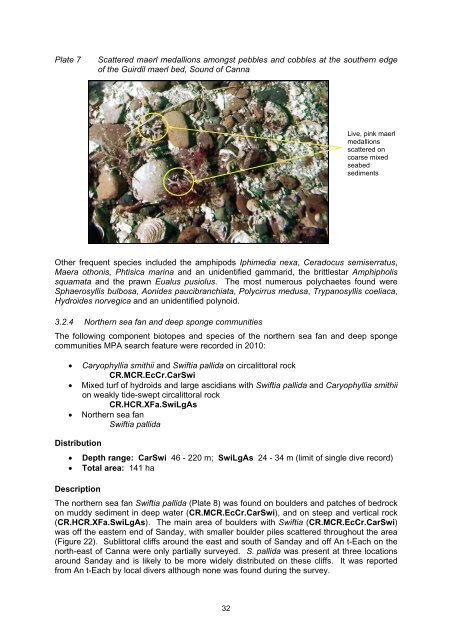Marine biological survey to establish the distribution and status of ...
Marine biological survey to establish the distribution and status of ...
Marine biological survey to establish the distribution and status of ...
You also want an ePaper? Increase the reach of your titles
YUMPU automatically turns print PDFs into web optimized ePapers that Google loves.
Plate 7<br />
Scattered maerl medallions amongst pebbles <strong>and</strong> cobbles at <strong>the</strong> sou<strong>the</strong>rn edge<br />
<strong>of</strong> <strong>the</strong> Guirdil maerl bed, Sound <strong>of</strong> Canna<br />
Live, pink maerl<br />
medallions<br />
scattered on<br />
coarse mixed<br />
seabed<br />
sediments<br />
O<strong>the</strong>r frequent species included <strong>the</strong> amphipods Iphimedia nexa, Ceradocus semiserratus,<br />
Maera othonis, Phtisica marina <strong>and</strong> an unidentified gammarid, <strong>the</strong> brittlestar Amphipholis<br />
squamata <strong>and</strong> <strong>the</strong> prawn Eualus pusiolus. The most numerous polychaetes found were<br />
Sphaerosyllis bulbosa, Aonides paucibranchiata, Polycirrus medusa, Trypanosyllis coeliaca,<br />
Hydroides norvegica <strong>and</strong> an unidentified polynoid.<br />
3.2.4 Nor<strong>the</strong>rn sea fan <strong>and</strong> deep sponge communities<br />
The following component bio<strong>to</strong>pes <strong>and</strong> species <strong>of</strong> <strong>the</strong> nor<strong>the</strong>rn sea fan <strong>and</strong> deep sponge<br />
communities MPA search feature were recorded in 2010:<br />
<br />
<br />
<br />
Caryophyllia smithii <strong>and</strong> Swiftia pallida on circalit<strong>to</strong>ral rock<br />
CR.MCR.EcCr.CarSwi<br />
Mixed turf <strong>of</strong> hydroids <strong>and</strong> large ascidians with Swiftia pallida <strong>and</strong> Caryophyllia smithii<br />
on weakly tide-swept circalit<strong>to</strong>ral rock<br />
CR.HCR.XFa.SwiLgAs<br />
Nor<strong>the</strong>rn sea fan<br />
Swiftia pallida<br />
Distribution<br />
<br />
<br />
Depth range: CarSwi 46 - 220 m; SwiLgAs 24 - 34 m (limit <strong>of</strong> single dive record)<br />
Total area: 141 ha<br />
Description<br />
The nor<strong>the</strong>rn sea fan Swiftia pallida (Plate 8) was found on boulders <strong>and</strong> patches <strong>of</strong> bedrock<br />
on muddy sediment in deep water (CR.MCR.EcCr.CarSwi), <strong>and</strong> on steep <strong>and</strong> vertical rock<br />
(CR.HCR.XFa.SwiLgAs). The main area <strong>of</strong> boulders with Swiftia (CR.MCR.EcCr.CarSwi)<br />
was <strong>of</strong>f <strong>the</strong> eastern end <strong>of</strong> S<strong>and</strong>ay, with smaller boulder piles scattered throughout <strong>the</strong> area<br />
(Figure 22). Sublit<strong>to</strong>ral cliffs around <strong>the</strong> east <strong>and</strong> south <strong>of</strong> S<strong>and</strong>ay <strong>and</strong> <strong>of</strong>f An t-Each on <strong>the</strong><br />
north-east <strong>of</strong> Canna were only partially <strong>survey</strong>ed. S. pallida was present at three locations<br />
around S<strong>and</strong>ay <strong>and</strong> is likely <strong>to</strong> be more widely distributed on <strong>the</strong>se cliffs. It was reported<br />
from An t-Each by local divers although none was found during <strong>the</strong> <strong>survey</strong>.<br />
32

















